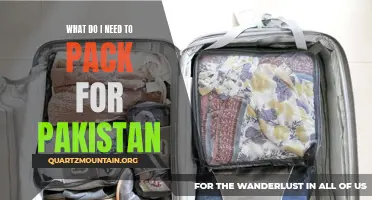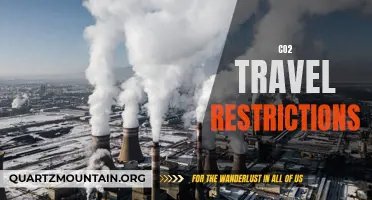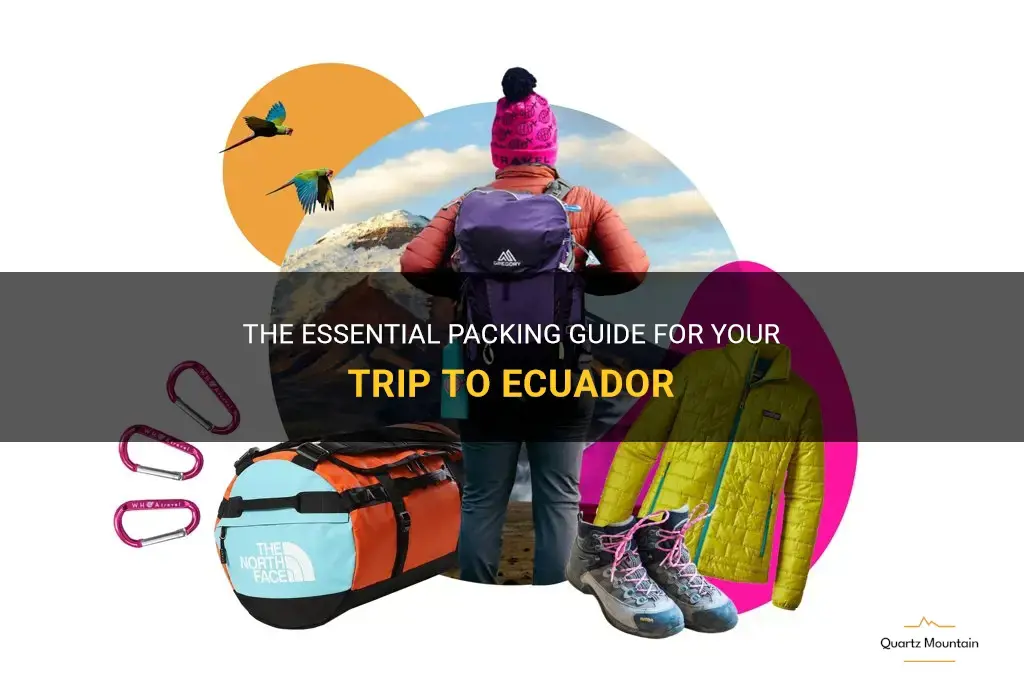
Are you planning a trip to Ecuador? Whether you're a seasoned traveler or it's your first time exploring this beautiful country, it's important to be prepared. From the lush rainforests of the Amazon to the breathtaking heights of the Andes Mountains, Ecuador offers a diverse range of landscapes and activities for every adventurer. But before you set off on your journey, it's crucial to pack the right essentials. In this guide, we'll walk you through the must-have items for your trip to Ecuador, ensuring you have everything you need for a comfortable and unforgettable experience. So grab your suitcase and get ready to embark on the adventure of a lifetime!
| Characteristics | Values |
|---|---|
| Climate | Varies widely depending on location and altitude; generally mild year-round with cooler temperatures in the mountains and warmer temperatures in coastal areas |
| Clothing | Lightweight, breathable clothing for warmer regions; layers and warmer clothing for higher elevations; rain jacket or poncho; sturdy footwear |
| Health and safety | Sunscreen, hat, sunglasses; insect repellent; necessary medications; travel insurance; first aid kit |
| Electronics | Power adapter; chargers for phone, camera, and other devices |
| Documents | Passport with at least 6 months validity; copy of passport; visa (if required); travel insurance documents; emergency contact information |
| Money | Local currency (US dollar); credit/debit cards; small bills for tips and local purchases |
| Travel gear | Backpack or daypack; travel locks; water bottle; reusable shopping bag; flashlight/headlamp; travel towel; travel pillow |
| Miscellaneous | Spanish phrasebook or translation app; travel guidebook or maps; camera; binoculars (for wildlife spotting) |
| Activities | Hiking gear (appropriate shoes, backpack, water bottle); snorkeling or diving equipment (if applicable); swimming attire |
| Entertainment | Books, magazines, or e-books; journal and pen; playing cards or small travel games |
What You'll Learn
- What are the essential items to pack for a trip to Ecuador?
- Should I bring a raincoat or umbrella for the unpredictable weather in Ecuador?
- Are there any specific clothing items that are culturally appropriate or inappropriate to wear in Ecuador?
- What types of shoes should I pack for exploring various terrains in Ecuador?
- Is it necessary to pack any specific medications or bug repellents for a trip to Ecuador?

What are the essential items to pack for a trip to Ecuador?
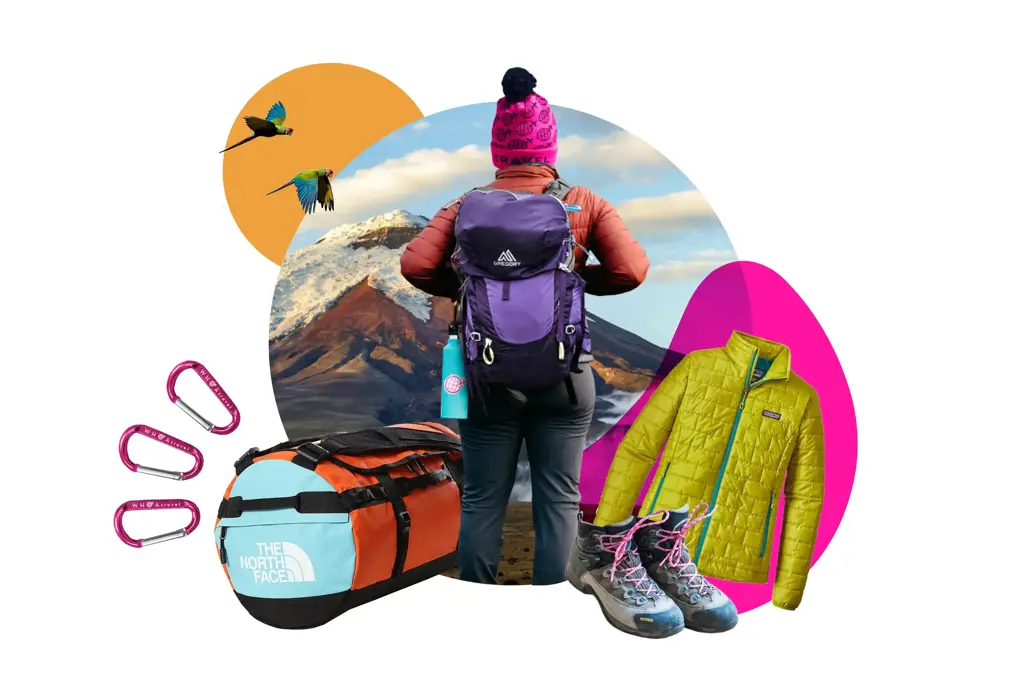
When preparing for a trip to Ecuador, it is important to pack the essential items that will make your travels comfortable and enjoyable. Ecuador is a diverse country with varying climates and landscapes, so it is important to pack accordingly. Whether you plan to explore the bustling cities, trek through the Amazon rainforest, or relax on the beautiful beaches, here are some essential items to consider packing for your trip to Ecuador.
- Clothing: Ecuador's climate can be unpredictable, so it is best to pack a variety of clothing options. Lightweight, breathable clothing is essential, especially for exploring the coastal areas and the Galapagos Islands where the temperatures can be quite warm. However, it is also important to pack some warm clothing, as the highlands and mountainous regions can get chilly, especially at night. Consider packing layers that can be easily added or removed depending on the weather. Additionally, don't forget to pack a waterproof jacket or poncho in case of rain.
- Comfortable walking shoes: Ecuador is a country that offers many opportunities for exploration, whether it's hiking through the Andes or exploring the cobblestone streets of colonial towns. Therefore, it's important to pack comfortable walking shoes that are suitable for various terrains. Opt for sturdy hiking boots or comfortable sneakers that provide good support for your feet.
- Insect repellent and sunscreen: Ecuador is home to a variety of insects, including mosquitoes. If you plan to spend time in the Amazon rainforest or other jungle areas, it is important to pack insect repellent to protect yourself from mosquito bites and other insect-borne diseases. Additionally, don't forget to pack sunscreen with a high SPF to protect your skin from the strong equatorial sun.
- Travel adapter: The electrical outlets in Ecuador are different from those in many other countries, so it is important to pack a travel adapter to ensure that you can charge your electronic devices. Ecuador uses Type A and Type B electrical outlets, so make sure to pack an adapter that is compatible with these types.
- Medications and first aid kit: It is always a good idea to pack a small kit with essential medications and a basic first aid kit. This should include any prescription medications you may need, as well as over-the-counter remedies for common ailments such as pain relievers, anti-diarrheal medication, and medication for motion sickness. Additionally, don't forget to pack any necessary personal hygiene items such as toiletries, hand sanitizers, and wet wipes.
- Money and travel documents: Don't forget to pack your passport, visa, and any other necessary travel documents. It is also important to bring some cash in the local currency (Ecuadorian Sucre) and have a back-up form of payment such as a credit or debit card. Make sure to inform your bank that you will be traveling to Ecuador to avoid any issues with your cards.
- Electronics: If you plan to use electronic devices such as cameras, smartphones, or laptops during your trip, make sure to pack the necessary chargers and adapters. It's also a good idea to bring a power bank or portable charger to ensure that you can charge your devices on the go, especially if you plan to spend time in remote areas.
In conclusion, packing the essential items for a trip to Ecuador will help ensure a comfortable and enjoyable experience. Consider the diverse climate and landscapes of Ecuador and pack clothing suitable for different weather conditions. Don't forget to pack comfortable walking shoes, insect repellent, sunscreen, a travel adapter, medications, and a first aid kit. Remember to bring your travel documents, money, and any necessary electronics. By packing smartly, you can make the most of your trip to the beautiful country of Ecuador.
Essential Items to Pack for a Memorable Trip to Gatlinburg
You may want to see also

Should I bring a raincoat or umbrella for the unpredictable weather in Ecuador?
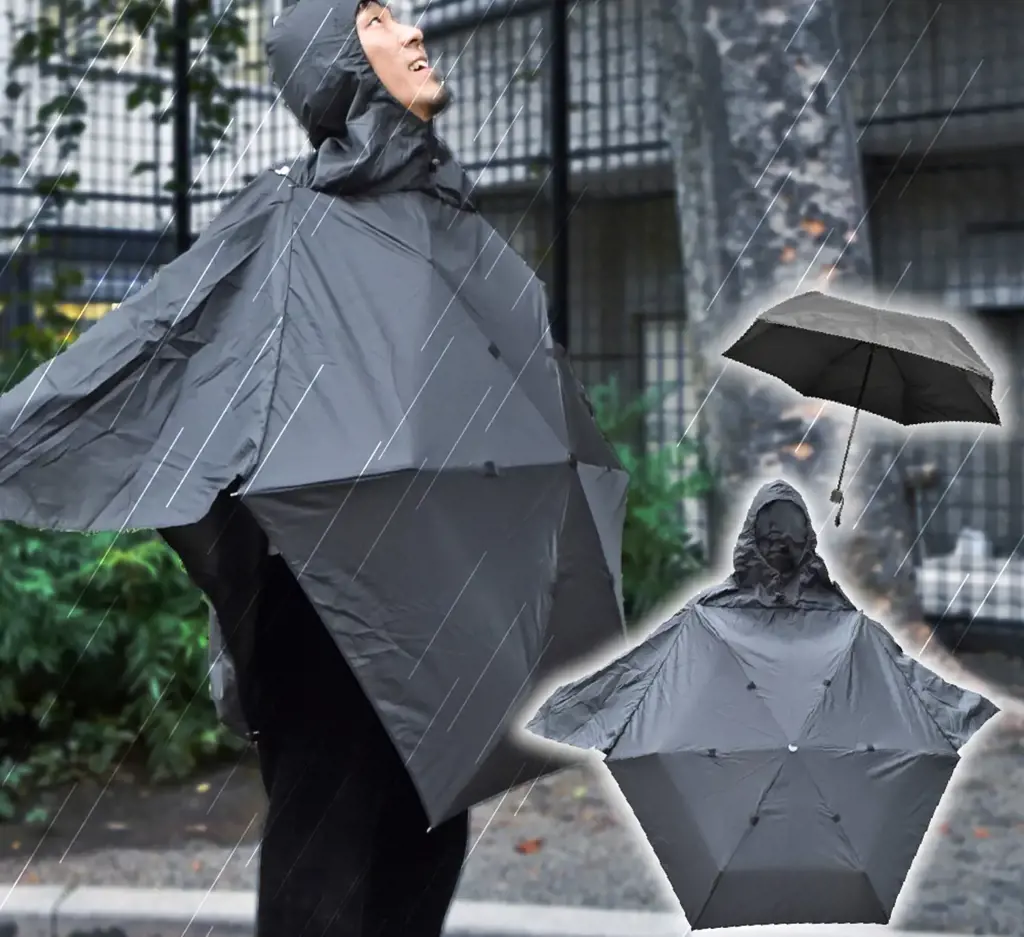
When planning a trip to Ecuador, it's essential to be prepared for the unpredictable weather. Ecuador is known for having a diverse climate, with weather patterns varying from region to region and even from day to day. One moment it can be sunny and hot, and the next moment it can be pouring rain. Therefore, it is highly recommended to bring both a raincoat and an umbrella to ensure that you are ready for whatever the weather may bring.
In terms of scientific evidence, Ecuador's weather can be attributed to several factors, including its location on the equator, its diverse geography, and the influence of ocean currents. The country experiences two main seasons: the wet season, which lasts from October to May, and the dry season, which lasts from June to September. However, even during the dry season, rain can still occur, especially in the highlands and cloud forests.
Based on personal experiences and the experiences of others who have traveled to Ecuador, it is clear that the weather can change rapidly throughout the day. For instance, you might start your morning with clear blue skies and sunshine, but by the afternoon, dark clouds can roll in, bringing heavy rain showers. This fluctuating weather pattern is particularly common in the coastal and mountainous regions of Ecuador.
To be fully prepared for the unpredictable weather, it is advisable to pack a lightweight raincoat that can easily be folded and carried in your daypack. A raincoat will not only keep you dry during sudden downpours but also act as a windbreaker in case of strong gusts. Look for a raincoat made of waterproof material such as Gore-Tex or nylon, as this will provide optimal protection against the rain.
In addition to a raincoat, it is also wise to bring an umbrella. While a raincoat is more versatile and can be worn throughout the day, an umbrella can provide extra shelter when the rain becomes heavy or if you are caught in a prolonged shower. Opt for a compact and sturdy umbrella that can withstand strong winds.
Lastly, it is worth mentioning a few examples of specific situations where having a raincoat or umbrella in Ecuador would be beneficial. Imagine you are hiking through the cloud forests of Mindo, a popular tourist destination known for its lush vegetation and heavy rainfall. Without a raincoat or umbrella, you would be drenched within minutes, making the hike uncomfortable and potentially dangerous. Similarly, if you are exploring the historic center of Quito and suddenly get caught in a sudden downpour, having an umbrella or raincoat would allow you to continue exploring without getting soaked.
In conclusion, the unpredictable weather in Ecuador necessitates the need to bring both a raincoat and an umbrella. The combination of these two items will ensure that you are prepared for any sudden changes in weather, whether you are exploring the cloud forests, hiking in the mountains, or strolling through the vibrant markets. By being prepared, you can fully enjoy all that Ecuador has to offer, regardless of the weather conditions.
Essential Items to Pack for a Relaxing Day at the Lake
You may want to see also

Are there any specific clothing items that are culturally appropriate or inappropriate to wear in Ecuador?
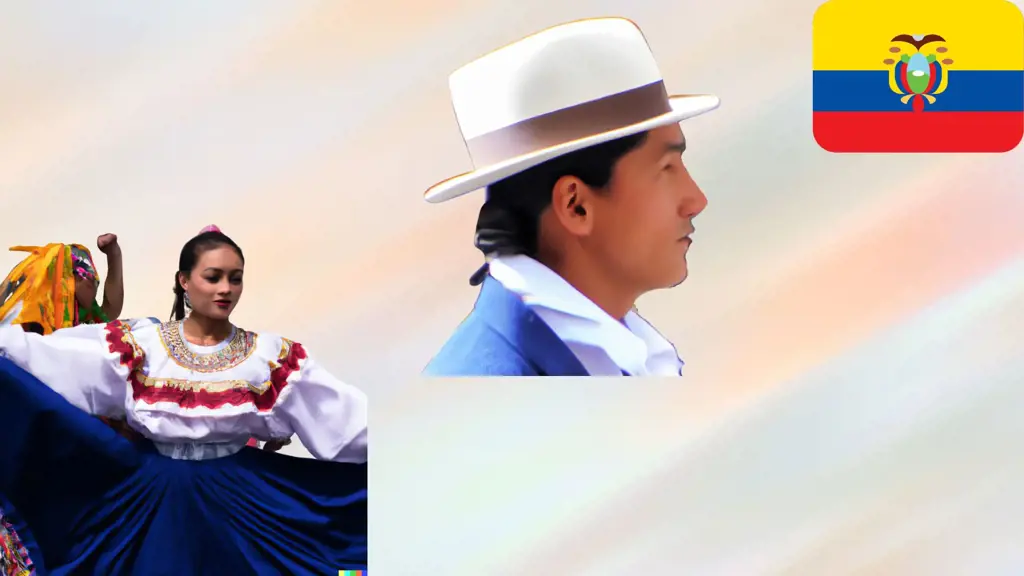
In Ecuador, as in many countries, there are certain clothing items that are considered culturally appropriate or inappropriate to wear. Understanding these cultural norms can help visitors and tourists show respect and avoid offending locals. Here are some key points to keep in mind when it comes to clothing in Ecuador:
- Modesty is valued: Ecuadorians tend to dress modestly, especially in more rural or conservative areas. It is generally frowned upon to wear revealing or overly tight clothing, particularly in religious or traditional settings. It is advisable to choose clothing that covers the shoulders, chest, and knees, especially when visiting churches, temples, or indigenous communities.
- Traditional clothing: Ecuador has a rich cultural heritage, and indigenous communities play a significant role in the country's identity. In some regions, traditional clothing is still commonly worn. For instance, in Otavalo, a town known for its vibrant indigenous market, you will see locals wearing traditional outfits consisting of colorful woven ponchos, skirts, and hats. While it is not expected for visitors to wear traditional clothing, appreciating and respecting these customs is important.
- Altitude considerations: Ecuador is known for its diverse geography, including high-altitude regions such as the Andes Mountains. If you plan to visit these areas, it is essential to dress appropriately for the colder temperatures, even if you are traveling during the summer months. Layered clothing, including long-sleeved shirts, sweaters, and jackets, is advisable to stay warm in the chilly mountainous regions.
- Beachwear: Ecuador is blessed with beautiful coastal areas where you can enjoy sun and sand. However, when it comes to beach attire, it is important to be mindful of cultural norms. While swimsuits and more revealing beachwear are generally acceptable on popular tourist beaches, it is advisable to cover up or use a sarong or cover-up when away from these areas or in more conservative coastal towns.
- Footwear: Ecuador is known for its diverse landscapes, including rugged terrain, rainforests, and cobblestone streets. It is recommended to wear comfortable and sturdy shoes suitable for walking, hiking, or exploring uneven surfaces. High heels or fancy footwear may not be practical or suitable for some areas.
- Occasional formal attire: Ecuadorians tend to dress up for special occasions and events, such as weddings, religious festivals, or formal gatherings. If you are invited to such an event, it is customary to dress appropriately in more formal attire, such as a suit or dress. It is always good to inquire about the dress code beforehand if unsure.
It is worth noting that Ecuador is a diverse country, and clothing norms can vary depending on the specific region, urban or rural setting, and cultural context. When in doubt, observing the locals and adopting a respectful and modest approach to dressing is advisable. By being aware of and respecting these cultural norms, visitors can enhance their experience, show appreciation for Ecuadorian culture, and avoid inadvertently offending anyone.
Packing Tips: Essential Items for a Transatlantic Cruise in April
You may want to see also

What types of shoes should I pack for exploring various terrains in Ecuador?
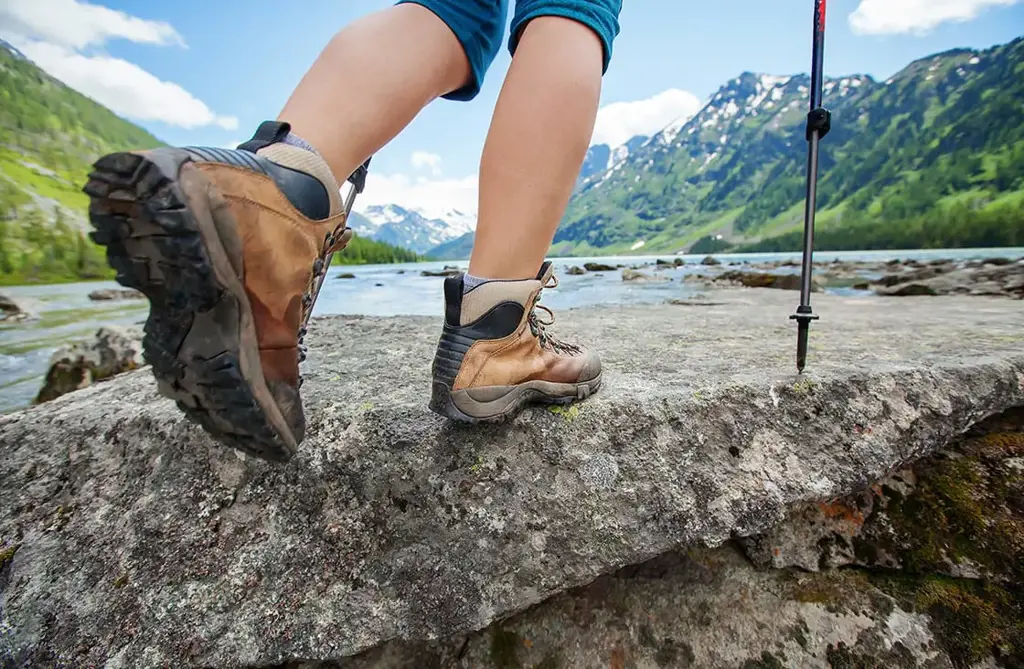
When it comes to exploring the diverse terrains in Ecuador, it is important to pack the right shoes to ensure comfort and safety during your adventures. Whether you are planning to hike through the lush rainforests, trek up the Andean peaks, or wander around the cobblestone streets of colonial towns, having the appropriate footwear will make your experience much more enjoyable. In this article, we will discuss the different types of shoes you should consider packing for exploring various terrains in Ecuador.
- Hiking Boots: If you are planning to venture into Ecuador's many national parks and hike through its breathtaking landscapes, a pair of sturdy hiking boots is a must. Look for boots that provide ankle support and have a durable and grippy sole. These boots are designed to handle uneven and slippery terrain, protecting your feet and ankles from injuries. Additionally, they provide excellent traction, allowing you to navigate steep inclines and rocky paths with ease.
- Trail Running Shoes: For those who prefer a lighter and more agile option, trail running shoes are an excellent choice. These shoes are designed to provide traction and stability on different surfaces, making them suitable for hiking and exploring. They are often constructed with breathable materials to keep your feet comfortable and minimize sweat. However, keep in mind that trail running shoes may not offer as much ankle support as hiking boots, so choose accordingly depending on the difficulty of the terrain you plan to explore.
- Sandals: While they may not be the first choice for hiking, a pair of sandals can be useful for exploring certain terrains in Ecuador. For example, if you plan to visit the Galapagos Islands or the coastal regions, sandals with a solid sole and straps that securely hold your feet in place are a great option. They provide ventilation and allow your feet to breathe in hot and humid conditions. Moreover, sandals are perfect for wading through shallow water or walking along sandy beaches.
- Comfortable Walking Shoes: If you are planning to explore Ecuador's cities and towns, a comfortable pair of walking shoes is essential. Opt for shoes that have cushioning and provide good arch support. Comfortable walking shoes will prevent your feet from getting tired and sore as you explore the charming streets and visit historical sites. It is important to choose shoes that are breathable to prevent your feet from sweating excessively on warmer days.
- Water Shoes: If your itinerary includes activities such as kayaking, rafting, or canyoning, it is essential to pack a pair of water shoes. These shoes are designed to provide protection and traction on wet surfaces. They typically have a quick-drying feature, preventing discomfort from waterlogged shoes. Water shoes can also be useful for exploring waterfalls or riverbanks, where you may encounter slippery rocks or uneven surfaces.
In addition to the shoes mentioned above, it is crucial to pack appropriate socks to ensure maximum comfort and prevent blisters. Choose moisture-wicking socks that provide cushioning and reduce friction between your feet and shoes.
Before your trip, it is advisable to break in your shoes to avoid discomfort and blisters during your adventures. Wear them for short walks or hikes to familiarize yourself with their fit and adaptability.
To sum up, when exploring Ecuador's diverse terrains, it is important to have the right footwear for various activities. Pack a pair of sturdy hiking boots or trail running shoes for hiking, comfortable walking shoes for city exploration, sandals for coastal regions, and water shoes for water activities. Remember to prioritize comfort, support, and protection when choosing your shoes to make the most out of your Ecuadorian adventure.
Essential Items to Pack for a December Trip to Arizona
You may want to see also

Is it necessary to pack any specific medications or bug repellents for a trip to Ecuador?
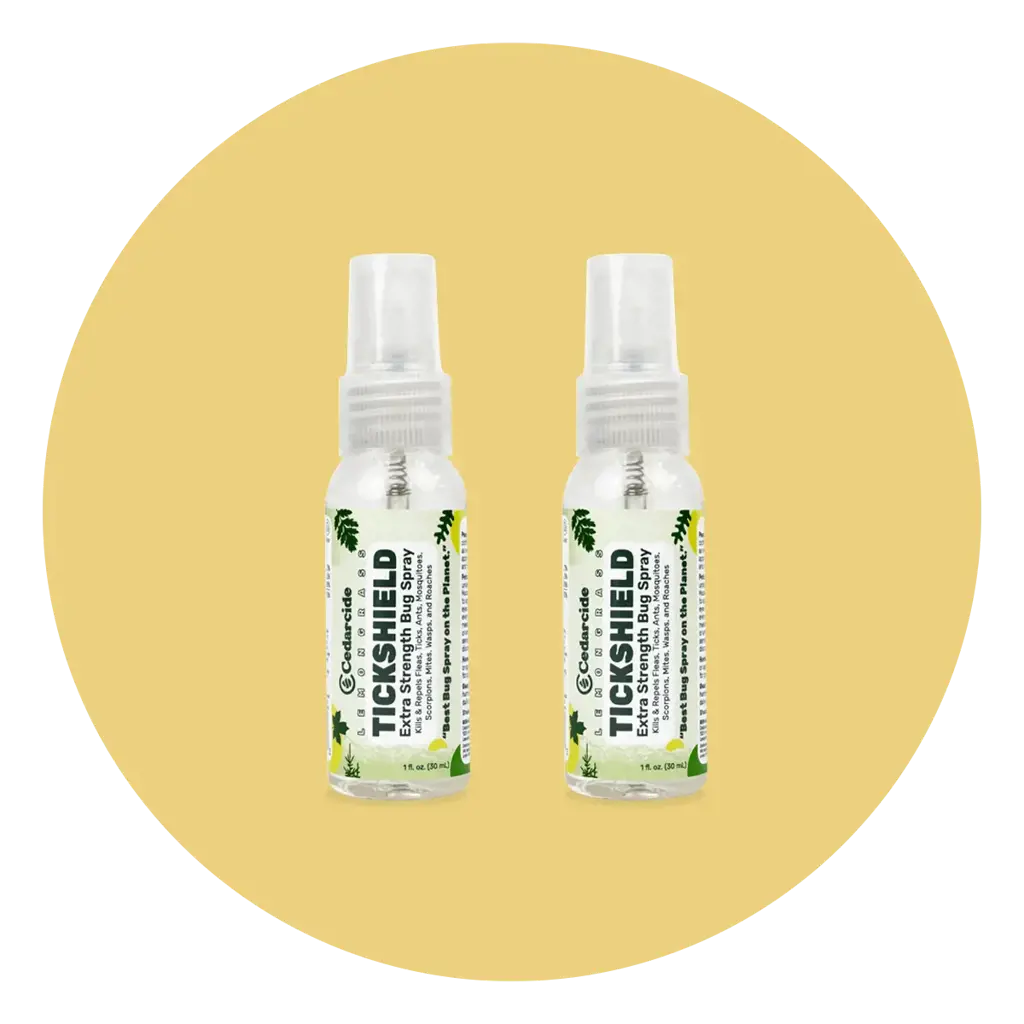
When traveling to Ecuador, it is important to take precautions to protect your health. As with any international trip, it is recommended to consult with a healthcare professional or travel medicine specialist before traveling to get personalized advice based on your specific health needs. However, there are some general recommendations for medications and bug repellents that can be beneficial for a trip to Ecuador.
Firstly, it is always advisable to pack a basic travel medicine kit that includes common over-the-counter medications such as pain relievers (ibuprofen or acetaminophen), antidiarrheal medications, and antihistamines. These medications can come in handy for minor ailments and provide relief for common symptoms. Having these medications readily available can help prevent minor health issues from escalating and can make your trip more comfortable.
In addition to the basic travel medicine kit, there are some specific medications that may be necessary when traveling to Ecuador. It is essential to check the vaccination requirements for Ecuador and ensure that you are up to date on routine vaccinations such as measles, mumps, rubella, diphtheria, tetanus, pertussis, and influenza. Additionally, some vaccinations such as yellow fever and typhoid may be recommended depending on the areas you plan to visit in Ecuador.
Ecuador is located in a region where mosquito-borne illnesses are prevalent, such as dengue fever, Zika virus, and chikungunya. Therefore, it is crucial to pack an effective bug repellent that contains ingredients such as DEET, picaridin, or lemon eucalyptus oil. These ingredients have been proven to repel mosquitoes effectively and reduce the risk of mosquito-borne diseases. It is important to apply bug repellent regularly, especially during dawn and dusk when mosquitoes are most active.
It is also advisable to wear long-sleeved shirts, long pants, and closed-toe shoes when venturing into areas with dense vegetation or during mosquito peak activity times. Additionally, consider packing permethrin-treated clothing or applying permethrin spray to clothing for added protection against mosquitoes and other biting insects.
In certain regions of Ecuador, such as the Amazon rainforest, there is a risk of contracting malaria. If you plan to visit these areas, it is important to consult with a healthcare professional or travel medicine specialist who can prescribe antimalarial medications based on your specific health needs and travel itinerary.
In conclusion, when traveling to Ecuador, it is necessary to pack specific medications and bug repellents to protect your health. Packing a basic travel medicine kit, staying up to date on routine vaccinations, and using effective bug repellents are essential for a safe and enjoyable trip. Consult with a healthcare professional or travel medicine specialist for personalized advice based on your health needs and travel itinerary. By taking the necessary precautions, you can significantly reduce the risk of health issues and fully enjoy your trip to Ecuador.
Essential Items to Pack for a Meaningful Mission Trip
You may want to see also
Frequently asked questions
When packing for Ecuador, it's important to pack layers of clothing as the weather can vary depending on the region and altitude. In the coastal areas, such as Guayaquil and the Galapagos Islands, lightweight and breathable clothing like t-shirts, shorts, and swimsuits are ideal due to the hot and humid climate. In the highland areas, such as Quito and Cuenca, temperatures can be cooler, especially in the evenings, so it's recommended to pack sweaters, long-sleeve shirts, and pants. Additionally, packing a rain jacket or waterproof outer layer is essential, as rain is common in many parts of the country throughout the year.
If you plan on hiking in Ecuador, it's important to pack appropriate gear to ensure your safety and comfort. This includes sturdy and comfortable hiking boots or shoes, as many trails in Ecuador can be rocky or uneven. It's also advisable to bring a good quality backpack to carry necessities such as water, snacks, a map, and a first aid kit. Other handy items to pack include a hat or cap to protect against the sun, sunscreen, insect repellent, and a lightweight and quick-drying towel. If you plan on camping, make sure to pack a tent and sleeping bag suitable for the conditions.
It's always a good idea to consult with your doctor or travel health clinic before visiting Ecuador to determine if any specific vaccinations or medications are recommended for your trip. In terms of general health supplies, it's advisable to pack a basic medical kit containing items such as band-aids, pain relievers, antiseptic cream, diarrhea medication, and any prescription medications you may need. It's also a good idea to bring a water filtration system or water purification tablets, as tap water in Ecuador is not always safe to drink.
In addition to clothing, hiking gear, and health supplies, there are a few other essential items you should consider packing for your trip to Ecuador. These include a universal travel adapter, as the country uses predominantly Type A and Type B electrical outlets, a travel guidebook or map for navigation and insight into local attractions, a money belt or secure bag to keep your valuables safe, a reusable water bottle to stay hydrated, and a camera or smartphone to capture memories of your trip. It's also a good idea to bring some cash in US dollars, as this is widely accepted in Ecuador.



